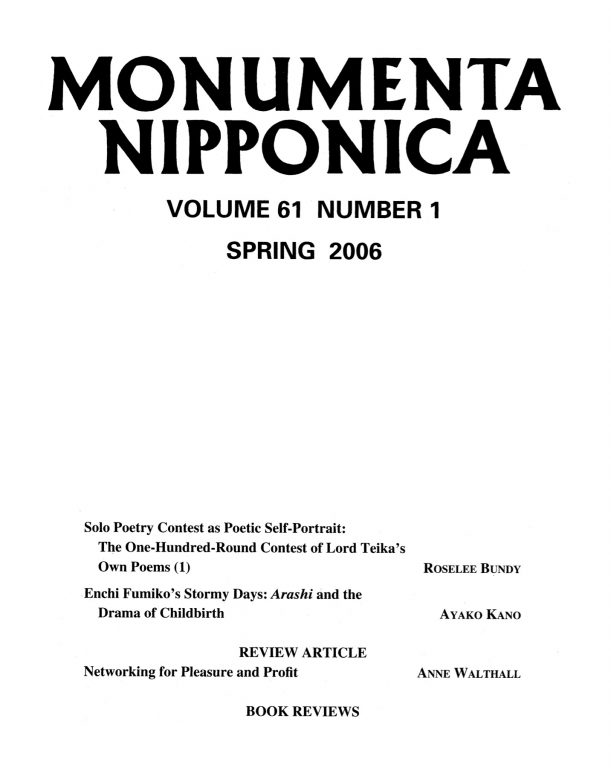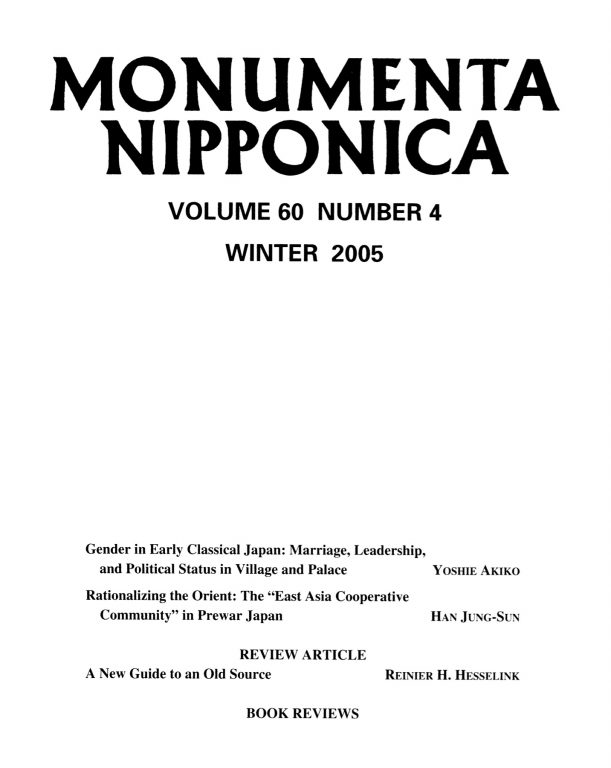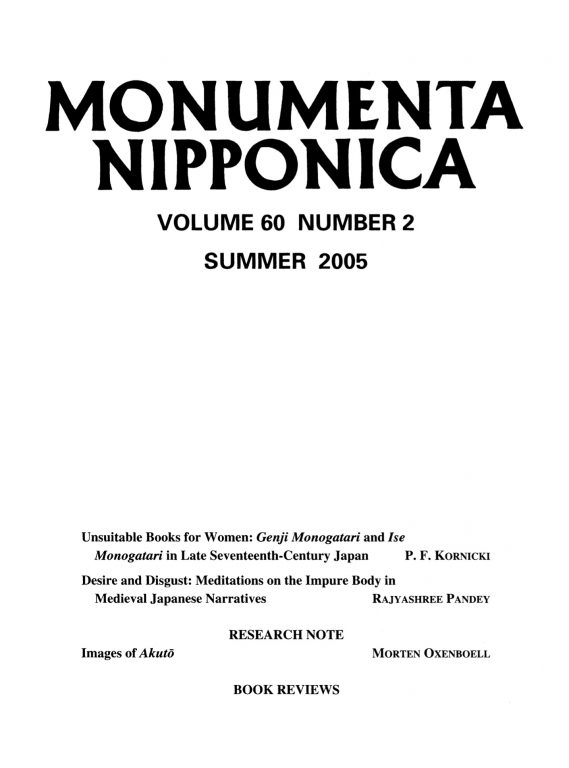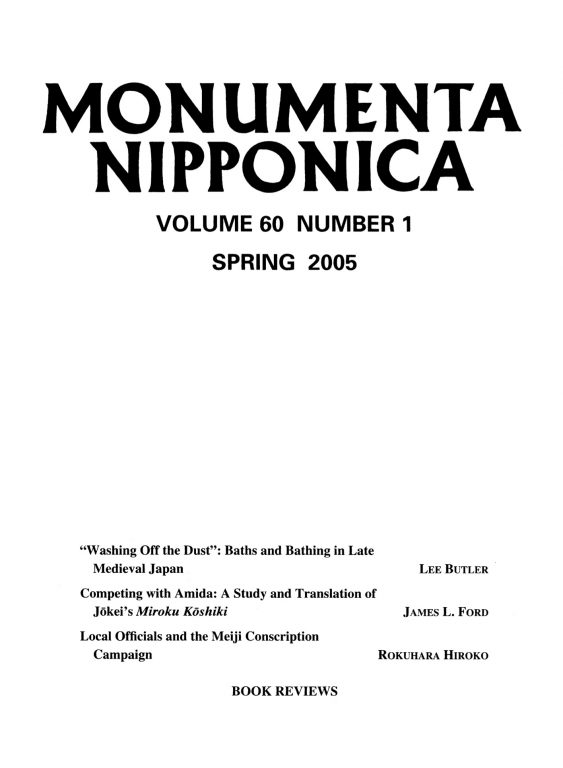Founded in 1938 and published semiannually by Sophia University MN 61:1 (2006) 107–12Written Texts—Visual Texts: Woodblock-Printed Media in Early Modern Japan ed. Susanne Formanek, Sepp LinhartMarcia Yonemoto
MN 61:1 (2006) 107–12Written Texts—Visual Texts: Woodblock-Printed Media in Early Modern Japan ed. Susanne Formanek, Sepp LinhartMarcia Yonemoto MN 61:1 (2006) 112–15Geographies of Identity in Nineteenth-Century Japan by David L. HowellBruce L. Batten
MN 61:1 (2006) 112–15Geographies of Identity in Nineteenth-Century Japan by David L. HowellBruce L. Batten MN 61:1 (2006) 115–17Burning and Building: Schooling and State Formation in Japan, 1750–1890 by Brian PlattDavid R. Ambaras
MN 61:1 (2006) 115–17Burning and Building: Schooling and State Formation in Japan, 1750–1890 by Brian PlattDavid R. Ambaras MN 61:1 (2006) 117–20Musashino in Tuscany: Japanese Overseas Travel Literature, 1860–1912 by Susanna FesslerMartin Collcutt
MN 61:1 (2006) 117–20Musashino in Tuscany: Japanese Overseas Travel Literature, 1860–1912 by Susanna FesslerMartin Collcutt MN 61:1 (2006) 120–23Rearranging the Landscape of the Gods: The Politics of a Pilgrimage Site in Japan, 1573–1912 by Sarah ThalNathalie Kouamé
MN 61:1 (2006) 120–23Rearranging the Landscape of the Gods: The Politics of a Pilgrimage Site in Japan, 1573–1912 by Sarah ThalNathalie Kouamé MN 61:1 (2006) 123–26Making Pilgrimages: Meaning and Practice in Shikoku by Ian ReaderMark MacWilliams
MN 61:1 (2006) 123–26Making Pilgrimages: Meaning and Practice in Shikoku by Ian ReaderMark MacWilliams MN 61:1 (2006) 126–29Language and Society in Japan by Nanette GottliebPatricia Wetzel
MN 61:1 (2006) 126–29Language and Society in Japan by Nanette GottliebPatricia Wetzel MN 60:4 (2005) 437–79Gender in Early Classical Japan: Marriage, Leadership, and Political Status in Village and PalaceAkiko Yoshie and Janet R. Goodwin
MN 60:4 (2005) 437–79Gender in Early Classical Japan: Marriage, Leadership, and Political Status in Village and PalaceAkiko Yoshie and Janet R. Goodwin MN 60:4 (2005) 481–514Rationalizing the Orient: The “East Asia Cooperative Community” in Prewar JapanHan Jung-Sun
MN 60:4 (2005) 481–514Rationalizing the Orient: The “East Asia Cooperative Community” in Prewar JapanHan Jung-Sun MN 60:4 (2005) 515–523A New Guide to an Old SourceReinier H. Hesselink
MN 60:4 (2005) 515–523A New Guide to an Old SourceReinier H. Hesselink MN 60:4 (2005) 525–528Ancient Jomon of Japan by Junko HabuGina L. Barnes
MN 60:4 (2005) 525–528Ancient Jomon of Japan by Junko HabuGina L. Barnes MN 60:4 (2005) 528–531Dismissed as Elegant Fossils: Konoe Nobutada and the Role of Aristocrats in Early Modern Japan by Lee Bruschke-JohnsonLee A. Butler
MN 60:4 (2005) 528–531Dismissed as Elegant Fossils: Konoe Nobutada and the Role of Aristocrats in Early Modern Japan by Lee Bruschke-JohnsonLee A. Butler MN 60:4 (2005) 531–533Cultural Commerce and Dutch Commercial Culture: The Influence of European Material Culture on Japan, 1700–1850 by Martha ChaiklinBruce L. Batten
MN 60:4 (2005) 531–533Cultural Commerce and Dutch Commercial Culture: The Influence of European Material Culture on Japan, 1700–1850 by Martha ChaiklinBruce L. Batten MN 60:4 (2005) 533–535Community and State in the Japanese Farm Village: Farm Tenancy Conciliation, 1924–1938 by Dimitri VanoverbekeSimon Partner
MN 60:4 (2005) 533–535Community and State in the Japanese Farm Village: Farm Tenancy Conciliation, 1924–1938 by Dimitri VanoverbekeSimon Partner MN 60:4 (2005) 536–538Figures poétiques japonaises: La genèse de la poésie en chaine by Sumie TeradaAileen Gatten
MN 60:4 (2005) 536–538Figures poétiques japonaises: La genèse de la poésie en chaine by Sumie TeradaAileen Gatten MN 60:4 (2005) 538–540Developing Zeami: The Noh Actor’s Attunement in Practice by Shelley Fenno QuinnEric C. Rath
MN 60:4 (2005) 538–540Developing Zeami: The Noh Actor’s Attunement in Practice by Shelley Fenno QuinnEric C. Rath MN 60:4 (2005) 541–542Discourses of Seduction: History, Evil, Desire, and Modern Japanese Literature by Hosea HirataAngela Yiu
MN 60:4 (2005) 541–542Discourses of Seduction: History, Evil, Desire, and Modern Japanese Literature by Hosea HirataAngela Yiu MN 60:4 (2005) 542–546Letters of the Nun Eshinni: Images of Pure Land Buddhism in Medieval Japan by James C. DobbinsDennis Hirota
MN 60:4 (2005) 542–546Letters of the Nun Eshinni: Images of Pure Land Buddhism in Medieval Japan by James C. DobbinsDennis Hirota MN 60:4 (2005) 546–549The Other Side of Zen: A Social History of Sōtō Zen Buddhism in Tokugawa Japan by Duncan Ryūken WilliamsDavid E. Riggs
MN 60:4 (2005) 546–549The Other Side of Zen: A Social History of Sōtō Zen Buddhism in Tokugawa Japan by Duncan Ryūken WilliamsDavid E. Riggs MN 60:3 (2005) 297–338War and Injury: The Emergence of Wound Medicine in Medieval JapanAndrew Edmund Goble
MN 60:3 (2005) 297–338War and Injury: The Emergence of Wound Medicine in Medieval JapanAndrew Edmund Goble MN 60:3 (2005) 339–91Female Pilgrims and Mt. Fuji: Changing Perspectives on the Exclusion of WomenFumiko Miyazaki
MN 60:3 (2005) 339–91Female Pilgrims and Mt. Fuji: Changing Perspectives on the Exclusion of WomenFumiko Miyazaki MN 60:3 (2005) 393–407Exercises in Biography: The Case of Takebe AyatariW. J. Boot
MN 60:3 (2005) 393–407Exercises in Biography: The Case of Takebe AyatariW. J. Boot MN 60:3 (2005) 409–12Japan’s Colonization of Korea: Discourse and Power by Alexis DuddenJames C. Baxter
MN 60:3 (2005) 409–12Japan’s Colonization of Korea: Discourse and Power by Alexis DuddenJames C. Baxter MN 60:3 (2005) 412–14Making Waves: Politics, Propaganda, and the Emergence of the Imperial Japanese Navy, 1868–1922 by J. Charles SchenckingMichael Lewis
MN 60:3 (2005) 412–14Making Waves: Politics, Propaganda, and the Emergence of the Imperial Japanese Navy, 1868–1922 by J. Charles SchenckingMichael Lewis MN 60:3 (2005) 415–17La modernité à l’horizon: la culture populaire dans le Japon des années vingt ed. Jean-Jacques Tschudin, Claude HamonSusan Napier
MN 60:3 (2005) 415–17La modernité à l’horizon: la culture populaire dans le Japon des années vingt ed. Jean-Jacques Tschudin, Claude HamonSusan Napier MN 60:3 (2005) 418–20Telling Lives: Women’s Self-Writing in Modern Japan ed. and trans. Ronald P. LoftusG. G. Rowley
MN 60:3 (2005) 418–20Telling Lives: Women’s Self-Writing in Modern Japan ed. and trans. Ronald P. LoftusG. G. Rowley MN 60:3 (2005) 420–22Politics, Memory and Public Opinion: The History Textbook Controversy and Japanese Society by Sven SaalerBob Tadashi Wakabayashi
MN 60:3 (2005) 420–22Politics, Memory and Public Opinion: The History Textbook Controversy and Japanese Society by Sven SaalerBob Tadashi Wakabayashi MN 60:3 (2005) 422–25Femmes galantes, femmes artistes dans le Japon ancien, XIe-XIIIe siècle by Jacqueline PigeotIvo Smits
MN 60:3 (2005) 422–25Femmes galantes, femmes artistes dans le Japon ancien, XIe-XIIIe siècle by Jacqueline PigeotIvo Smits MN 60:3 (2005) 425–34Kabuki Plays On Stage ed. James R. Brandon, Samuel L. LeiterJanet E. Goff
MN 60:3 (2005) 425–34Kabuki Plays On Stage ed. James R. Brandon, Samuel L. LeiterJanet E. Goff MN 60:3 (2005) 434–36The Japanese Self in Cultural Logic by Takie Sugiyama LebraHarumi Befu
MN 60:3 (2005) 434–36The Japanese Self in Cultural Logic by Takie Sugiyama LebraHarumi Befu MN 60:2 (2005) 147–93Unsuitable Books for Women?: Genji Monogatari and Ise Monogatari in Late Seventeenth-Century JapanPeter F. Kornicki
MN 60:2 (2005) 147–93Unsuitable Books for Women?: Genji Monogatari and Ise Monogatari in Late Seventeenth-Century JapanPeter F. Kornicki MN 60:2 (2005) 195–234Desire and Disgust: Meditations on the Impure Body in Medieval Japanese NarrativesRajyashree Pandey
MN 60:2 (2005) 195–234Desire and Disgust: Meditations on the Impure Body in Medieval Japanese NarrativesRajyashree Pandey MN 60:2 (2005) 235–62Images of AkutōMorten Oxenboell
MN 60:2 (2005) 235–62Images of AkutōMorten Oxenboell MN 60:2 (2005) 263–64The Tōkaidō Road: Traveling and Representation in Edo and Meiji Japan by Jilly TraganouLawrence E. Marceau
MN 60:2 (2005) 263–64The Tōkaidō Road: Traveling and Representation in Edo and Meiji Japan by Jilly TraganouLawrence E. Marceau MN 60:2 (2005) 265–67Interracial Intimacy in Japan: Western Men and Japanese Women, 1543–1900 by Gary P. LeuppSusan L. Burns
MN 60:2 (2005) 265–67Interracial Intimacy in Japan: Western Men and Japanese Women, 1543–1900 by Gary P. LeuppSusan L. Burns MN 60:2 (2005) 267–69Japan’s Early Experience of Contract Management in the Treaty Ports by Yuki Allyson HonjoJunko Ando
MN 60:2 (2005) 267–69Japan’s Early Experience of Contract Management in the Treaty Ports by Yuki Allyson HonjoJunko Ando MN 60:2 (2005) 269–72Hiratsuka Raichō and Early Japanese Feminism by Hiroko TomidaAndrea Germer
MN 60:2 (2005) 269–72Hiratsuka Raichō and Early Japanese Feminism by Hiroko TomidaAndrea Germer MN 60:2 (2005) 272–75Historische Frauenforschung in Japan: Die Rekonstruktion der Vergangenheit in Takamure Itsues “Geschichte der Frau” (Josei no rekishi) by Andrea GermerUlrike Wöhr
MN 60:2 (2005) 272–75Historische Frauenforschung in Japan: Die Rekonstruktion der Vergangenheit in Takamure Itsues “Geschichte der Frau” (Josei no rekishi) by Andrea GermerUlrike Wöhr MN 60:2 (2005) 275–78At the House of Gathered Leaves: Short Biographical and Autobiographical Narratives from Japanese Court Literature by Joshua S. MostowLynne K. Miyake
MN 60:2 (2005) 275–78At the House of Gathered Leaves: Short Biographical and Autobiographical Narratives from Japanese Court Literature by Joshua S. MostowLynne K. Miyake MN 60:2 (2005) 278–81Writing Home: Representations of the Native Place in Modern Japanese Literature by Stephen DoddDennis Washburn
MN 60:2 (2005) 278–81Writing Home: Representations of the Native Place in Modern Japanese Literature by Stephen DoddDennis Washburn MN 60:2 (2005) 281–83The Body in Postwar Japanese Fiction by Douglas N. SlaymakerJoseph S. O'Leary
MN 60:2 (2005) 281–83The Body in Postwar Japanese Fiction by Douglas N. SlaymakerJoseph S. O'Leary MN 60:2 (2005) 283–88Keigo in Modern Japan: Polite Language from Meiji to the Present by Patricia J. Wetzel; Rhetoric in Modern Japan: Western Influences on the Development of Narrative and Oratorical Style by Massimiliano TomasiNanette Gottlieb
MN 60:2 (2005) 283–88Keigo in Modern Japan: Polite Language from Meiji to the Present by Patricia J. Wetzel; Rhetoric in Modern Japan: Western Influences on the Development of Narrative and Oratorical Style by Massimiliano TomasiNanette Gottlieb MN 60:2 (2005) 288–90Tsukiji: The Fish Market at the Center of the World by Theodore BestorAnne Allison
MN 60:2 (2005) 288–90Tsukiji: The Fish Market at the Center of the World by Theodore BestorAnne Allison MN 60:2 (2005) 290–93Identity and Ritual in a Japanese Diving Village: The Making and Becoming of Person and Place by D. P. MartinezBirgit Staemmler
MN 60:2 (2005) 290–93Identity and Ritual in a Japanese Diving Village: The Making and Becoming of Person and Place by D. P. MartinezBirgit Staemmler MN 60:2 (2005) 293–95The Koto: A Traditional Instrument in Contemporary Japan by Henry JohnsonDavid Waterhouse
MN 60:2 (2005) 293–95The Koto: A Traditional Instrument in Contemporary Japan by Henry JohnsonDavid Waterhouse MN 60:1 (2005) 1–41“Washing Off the Dust”: Baths and Bathing in Late Medieval JapanLee A. Butler
MN 60:1 (2005) 1–41“Washing Off the Dust”: Baths and Bathing in Late Medieval JapanLee A. Butler MN 60:1 (2005) 43–79Competing with Amida: A Study and Translation of Jōkei’s Miroku KōshikiJames L. Ford
MN 60:1 (2005) 43–79Competing with Amida: A Study and Translation of Jōkei’s Miroku KōshikiJames L. Ford MN 60:1 (2005) 65–79Jōkei’s Five Part Miroku Kōshiki (c. 1196): A TranslationJōkei, Translated by James L. Ford
MN 60:1 (2005) 65–79Jōkei’s Five Part Miroku Kōshiki (c. 1196): A TranslationJōkei, Translated by James L. Ford
 MN 61:1 (2006) 107–12Written Texts—Visual Texts: Woodblock-Printed Media in Early Modern Japan ed. Susanne Formanek, Sepp LinhartMarcia Yonemoto
MN 61:1 (2006) 107–12Written Texts—Visual Texts: Woodblock-Printed Media in Early Modern Japan ed. Susanne Formanek, Sepp LinhartMarcia Yonemoto MN 61:1 (2006) 112–15Geographies of Identity in Nineteenth-Century Japan by David L. HowellBruce L. Batten
MN 61:1 (2006) 112–15Geographies of Identity in Nineteenth-Century Japan by David L. HowellBruce L. Batten MN 61:1 (2006) 115–17Burning and Building: Schooling and State Formation in Japan, 1750–1890 by Brian PlattDavid R. Ambaras
MN 61:1 (2006) 115–17Burning and Building: Schooling and State Formation in Japan, 1750–1890 by Brian PlattDavid R. Ambaras MN 61:1 (2006) 117–20Musashino in Tuscany: Japanese Overseas Travel Literature, 1860–1912 by Susanna FesslerMartin Collcutt
MN 61:1 (2006) 117–20Musashino in Tuscany: Japanese Overseas Travel Literature, 1860–1912 by Susanna FesslerMartin Collcutt MN 61:1 (2006) 120–23Rearranging the Landscape of the Gods: The Politics of a Pilgrimage Site in Japan, 1573–1912 by Sarah ThalNathalie Kouamé
MN 61:1 (2006) 120–23Rearranging the Landscape of the Gods: The Politics of a Pilgrimage Site in Japan, 1573–1912 by Sarah ThalNathalie Kouamé MN 61:1 (2006) 123–26Making Pilgrimages: Meaning and Practice in Shikoku by Ian ReaderMark MacWilliams
MN 61:1 (2006) 123–26Making Pilgrimages: Meaning and Practice in Shikoku by Ian ReaderMark MacWilliams MN 61:1 (2006) 126–29Language and Society in Japan by Nanette GottliebPatricia Wetzel
MN 61:1 (2006) 126–29Language and Society in Japan by Nanette GottliebPatricia Wetzel MN 60:4 (2005) 437–79Gender in Early Classical Japan: Marriage, Leadership, and Political Status in Village and PalaceAkiko Yoshie and Janet R. Goodwin
MN 60:4 (2005) 437–79Gender in Early Classical Japan: Marriage, Leadership, and Political Status in Village and PalaceAkiko Yoshie and Janet R. Goodwin MN 60:4 (2005) 481–514Rationalizing the Orient: The “East Asia Cooperative Community” in Prewar JapanHan Jung-Sun
MN 60:4 (2005) 481–514Rationalizing the Orient: The “East Asia Cooperative Community” in Prewar JapanHan Jung-Sun MN 60:4 (2005) 515–523A New Guide to an Old SourceReinier H. Hesselink
MN 60:4 (2005) 515–523A New Guide to an Old SourceReinier H. Hesselink MN 60:4 (2005) 525–528Ancient Jomon of Japan by Junko HabuGina L. Barnes
MN 60:4 (2005) 525–528Ancient Jomon of Japan by Junko HabuGina L. Barnes MN 60:4 (2005) 528–531Dismissed as Elegant Fossils: Konoe Nobutada and the Role of Aristocrats in Early Modern Japan by Lee Bruschke-JohnsonLee A. Butler
MN 60:4 (2005) 528–531Dismissed as Elegant Fossils: Konoe Nobutada and the Role of Aristocrats in Early Modern Japan by Lee Bruschke-JohnsonLee A. Butler MN 60:4 (2005) 531–533Cultural Commerce and Dutch Commercial Culture: The Influence of European Material Culture on Japan, 1700–1850 by Martha ChaiklinBruce L. Batten
MN 60:4 (2005) 531–533Cultural Commerce and Dutch Commercial Culture: The Influence of European Material Culture on Japan, 1700–1850 by Martha ChaiklinBruce L. Batten MN 60:4 (2005) 533–535Community and State in the Japanese Farm Village: Farm Tenancy Conciliation, 1924–1938 by Dimitri VanoverbekeSimon Partner
MN 60:4 (2005) 533–535Community and State in the Japanese Farm Village: Farm Tenancy Conciliation, 1924–1938 by Dimitri VanoverbekeSimon Partner MN 60:4 (2005) 536–538Figures poétiques japonaises: La genèse de la poésie en chaine by Sumie TeradaAileen Gatten
MN 60:4 (2005) 536–538Figures poétiques japonaises: La genèse de la poésie en chaine by Sumie TeradaAileen Gatten MN 60:4 (2005) 538–540Developing Zeami: The Noh Actor’s Attunement in Practice by Shelley Fenno QuinnEric C. Rath
MN 60:4 (2005) 538–540Developing Zeami: The Noh Actor’s Attunement in Practice by Shelley Fenno QuinnEric C. Rath MN 60:4 (2005) 541–542Discourses of Seduction: History, Evil, Desire, and Modern Japanese Literature by Hosea HirataAngela Yiu
MN 60:4 (2005) 541–542Discourses of Seduction: History, Evil, Desire, and Modern Japanese Literature by Hosea HirataAngela Yiu MN 60:4 (2005) 542–546Letters of the Nun Eshinni: Images of Pure Land Buddhism in Medieval Japan by James C. DobbinsDennis Hirota
MN 60:4 (2005) 542–546Letters of the Nun Eshinni: Images of Pure Land Buddhism in Medieval Japan by James C. DobbinsDennis Hirota MN 60:4 (2005) 546–549The Other Side of Zen: A Social History of Sōtō Zen Buddhism in Tokugawa Japan by Duncan Ryūken WilliamsDavid E. Riggs
MN 60:4 (2005) 546–549The Other Side of Zen: A Social History of Sōtō Zen Buddhism in Tokugawa Japan by Duncan Ryūken WilliamsDavid E. Riggs MN 60:3 (2005) 297–338War and Injury: The Emergence of Wound Medicine in Medieval JapanAndrew Edmund Goble
MN 60:3 (2005) 297–338War and Injury: The Emergence of Wound Medicine in Medieval JapanAndrew Edmund Goble MN 60:3 (2005) 339–91Female Pilgrims and Mt. Fuji: Changing Perspectives on the Exclusion of WomenFumiko Miyazaki
MN 60:3 (2005) 339–91Female Pilgrims and Mt. Fuji: Changing Perspectives on the Exclusion of WomenFumiko Miyazaki MN 60:3 (2005) 393–407Exercises in Biography: The Case of Takebe AyatariW. J. Boot
MN 60:3 (2005) 393–407Exercises in Biography: The Case of Takebe AyatariW. J. Boot MN 60:3 (2005) 409–12Japan’s Colonization of Korea: Discourse and Power by Alexis DuddenJames C. Baxter
MN 60:3 (2005) 409–12Japan’s Colonization of Korea: Discourse and Power by Alexis DuddenJames C. Baxter MN 60:3 (2005) 412–14Making Waves: Politics, Propaganda, and the Emergence of the Imperial Japanese Navy, 1868–1922 by J. Charles SchenckingMichael Lewis
MN 60:3 (2005) 412–14Making Waves: Politics, Propaganda, and the Emergence of the Imperial Japanese Navy, 1868–1922 by J. Charles SchenckingMichael Lewis MN 60:3 (2005) 415–17La modernité à l’horizon: la culture populaire dans le Japon des années vingt ed. Jean-Jacques Tschudin, Claude HamonSusan Napier
MN 60:3 (2005) 415–17La modernité à l’horizon: la culture populaire dans le Japon des années vingt ed. Jean-Jacques Tschudin, Claude HamonSusan Napier MN 60:3 (2005) 418–20Telling Lives: Women’s Self-Writing in Modern Japan ed. and trans. Ronald P. LoftusG. G. Rowley
MN 60:3 (2005) 418–20Telling Lives: Women’s Self-Writing in Modern Japan ed. and trans. Ronald P. LoftusG. G. Rowley MN 60:3 (2005) 420–22Politics, Memory and Public Opinion: The History Textbook Controversy and Japanese Society by Sven SaalerBob Tadashi Wakabayashi
MN 60:3 (2005) 420–22Politics, Memory and Public Opinion: The History Textbook Controversy and Japanese Society by Sven SaalerBob Tadashi Wakabayashi MN 60:3 (2005) 422–25Femmes galantes, femmes artistes dans le Japon ancien, XIe-XIIIe siècle by Jacqueline PigeotIvo Smits
MN 60:3 (2005) 422–25Femmes galantes, femmes artistes dans le Japon ancien, XIe-XIIIe siècle by Jacqueline PigeotIvo Smits MN 60:3 (2005) 425–34Kabuki Plays On Stage ed. James R. Brandon, Samuel L. LeiterJanet E. Goff
MN 60:3 (2005) 425–34Kabuki Plays On Stage ed. James R. Brandon, Samuel L. LeiterJanet E. Goff MN 60:3 (2005) 434–36The Japanese Self in Cultural Logic by Takie Sugiyama LebraHarumi Befu
MN 60:3 (2005) 434–36The Japanese Self in Cultural Logic by Takie Sugiyama LebraHarumi Befu MN 60:2 (2005) 147–93Unsuitable Books for Women?: Genji Monogatari and Ise Monogatari in Late Seventeenth-Century JapanPeter F. Kornicki
MN 60:2 (2005) 147–93Unsuitable Books for Women?: Genji Monogatari and Ise Monogatari in Late Seventeenth-Century JapanPeter F. Kornicki MN 60:2 (2005) 195–234Desire and Disgust: Meditations on the Impure Body in Medieval Japanese NarrativesRajyashree Pandey
MN 60:2 (2005) 195–234Desire and Disgust: Meditations on the Impure Body in Medieval Japanese NarrativesRajyashree Pandey MN 60:2 (2005) 235–62Images of AkutōMorten Oxenboell
MN 60:2 (2005) 235–62Images of AkutōMorten Oxenboell MN 60:2 (2005) 263–64The Tōkaidō Road: Traveling and Representation in Edo and Meiji Japan by Jilly TraganouLawrence E. Marceau
MN 60:2 (2005) 263–64The Tōkaidō Road: Traveling and Representation in Edo and Meiji Japan by Jilly TraganouLawrence E. Marceau MN 60:2 (2005) 265–67Interracial Intimacy in Japan: Western Men and Japanese Women, 1543–1900 by Gary P. LeuppSusan L. Burns
MN 60:2 (2005) 265–67Interracial Intimacy in Japan: Western Men and Japanese Women, 1543–1900 by Gary P. LeuppSusan L. Burns MN 60:2 (2005) 267–69Japan’s Early Experience of Contract Management in the Treaty Ports by Yuki Allyson HonjoJunko Ando
MN 60:2 (2005) 267–69Japan’s Early Experience of Contract Management in the Treaty Ports by Yuki Allyson HonjoJunko Ando MN 60:2 (2005) 269–72Hiratsuka Raichō and Early Japanese Feminism by Hiroko TomidaAndrea Germer
MN 60:2 (2005) 269–72Hiratsuka Raichō and Early Japanese Feminism by Hiroko TomidaAndrea Germer MN 60:2 (2005) 272–75Historische Frauenforschung in Japan: Die Rekonstruktion der Vergangenheit in Takamure Itsues “Geschichte der Frau” (Josei no rekishi) by Andrea GermerUlrike Wöhr
MN 60:2 (2005) 272–75Historische Frauenforschung in Japan: Die Rekonstruktion der Vergangenheit in Takamure Itsues “Geschichte der Frau” (Josei no rekishi) by Andrea GermerUlrike Wöhr MN 60:2 (2005) 275–78At the House of Gathered Leaves: Short Biographical and Autobiographical Narratives from Japanese Court Literature by Joshua S. MostowLynne K. Miyake
MN 60:2 (2005) 275–78At the House of Gathered Leaves: Short Biographical and Autobiographical Narratives from Japanese Court Literature by Joshua S. MostowLynne K. Miyake MN 60:2 (2005) 278–81Writing Home: Representations of the Native Place in Modern Japanese Literature by Stephen DoddDennis Washburn
MN 60:2 (2005) 278–81Writing Home: Representations of the Native Place in Modern Japanese Literature by Stephen DoddDennis Washburn MN 60:2 (2005) 281–83The Body in Postwar Japanese Fiction by Douglas N. SlaymakerJoseph S. O'Leary
MN 60:2 (2005) 281–83The Body in Postwar Japanese Fiction by Douglas N. SlaymakerJoseph S. O'Leary MN 60:2 (2005) 283–88Keigo in Modern Japan: Polite Language from Meiji to the Present by Patricia J. Wetzel; Rhetoric in Modern Japan: Western Influences on the Development of Narrative and Oratorical Style by Massimiliano TomasiNanette Gottlieb
MN 60:2 (2005) 283–88Keigo in Modern Japan: Polite Language from Meiji to the Present by Patricia J. Wetzel; Rhetoric in Modern Japan: Western Influences on the Development of Narrative and Oratorical Style by Massimiliano TomasiNanette Gottlieb MN 60:2 (2005) 288–90Tsukiji: The Fish Market at the Center of the World by Theodore BestorAnne Allison
MN 60:2 (2005) 288–90Tsukiji: The Fish Market at the Center of the World by Theodore BestorAnne Allison MN 60:2 (2005) 290–93Identity and Ritual in a Japanese Diving Village: The Making and Becoming of Person and Place by D. P. MartinezBirgit Staemmler
MN 60:2 (2005) 290–93Identity and Ritual in a Japanese Diving Village: The Making and Becoming of Person and Place by D. P. MartinezBirgit Staemmler MN 60:2 (2005) 293–95The Koto: A Traditional Instrument in Contemporary Japan by Henry JohnsonDavid Waterhouse
MN 60:2 (2005) 293–95The Koto: A Traditional Instrument in Contemporary Japan by Henry JohnsonDavid Waterhouse MN 60:1 (2005) 1–41“Washing Off the Dust”: Baths and Bathing in Late Medieval JapanLee A. Butler
MN 60:1 (2005) 1–41“Washing Off the Dust”: Baths and Bathing in Late Medieval JapanLee A. Butler MN 60:1 (2005) 43–79Competing with Amida: A Study and Translation of Jōkei’s Miroku KōshikiJames L. Ford
MN 60:1 (2005) 43–79Competing with Amida: A Study and Translation of Jōkei’s Miroku KōshikiJames L. Ford MN 60:1 (2005) 65–79Jōkei’s Five Part Miroku Kōshiki (c. 1196): A TranslationJōkei, Translated by James L. Ford
MN 60:1 (2005) 65–79Jōkei’s Five Part Miroku Kōshiki (c. 1196): A TranslationJōkei, Translated by James L. Ford